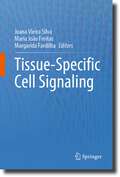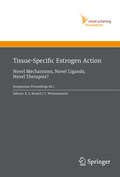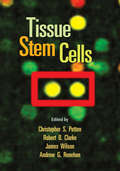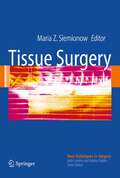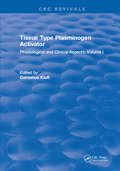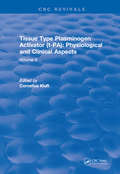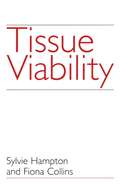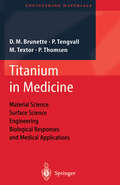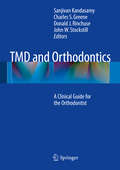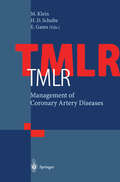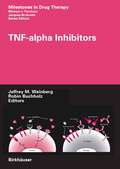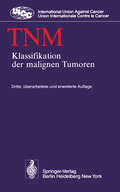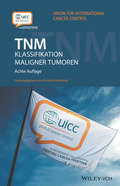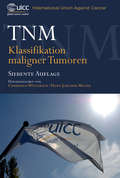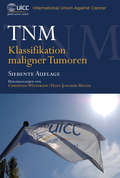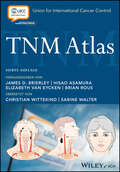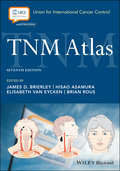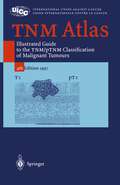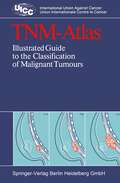- Table View
- List View
Tissue-Specific Cell Signaling
by Joana Vieira Silva Maria João Freitas Margarida FardilhaSignal transduction comprises the intracellular biochemical signals which induce the appropriate cell response to an external stimulus. The players in signal transduction are diverse, from small molecules as first messengers, to proteins, receptors, transcription factors, among many others. The different signaling pathways and the crosstalk between them originates the unique signaling profile of every cell type in the human body. The cell signaling specificity depends on several aspects including protein composition, subcellular localization and complexes and gene promoters.This textbook provides a comprehensive overview of the specific signaling pathways on a variety of human tissues. This information can be of great value for health science researchers, professionals and students to understand key pathways for tissue-specific functions in the plethora of signals, signals receptors, transducers and effectors.Chapter 3 and 15 are available open access under a Creative Commons Attribution 4.0 International License via link.springer.com.
Tissue-Specific Estrogen Action: Novel Mechanisms, Novel Ligands, Novel Therapies (Ernst Schering Foundation Symposium Proceedings #2006/1)
by K. S. Korach T. M. WintermantelCurrent molecular understanding of estrogen action has greatly profited from advances in molecular cell biology. These advances, and their implications for clinical use, were discussed by leading researchers from industry and academia during an international symposium held in Berlin, 1-3 March 2006 and are featured in this volume.
Tissue Stem Cells
by Christopher S. Potten Robert B. Clarke Andrew G. Renehan James WilsonTissue stem cells and their medical applications have become a major focus of research over the past decade. With 16 full-color illustrations, this reference provides a thorough and up-to-date overview of the current and emerging technologies for stem cell research and transplantation. Divided into three sections covering general issues, adult stem
Tissue Surgery (New Techniques in Surgery Series #1)
by Maria Z. SiemionowA definitive summary of novel techniques, this volume details the most current and multidisciplinary approach to new technologies used in general plastic surgery, hand surgery, peripheral nerve surgery, microsurgery, breast surgery, esthetic surgery, and trauma surgery. It also gives an overview of the most important and clinically relevant plastic surgery research. The aim is to stimulate the reader to look at future advances and applications of research and their relevance to daily clinical practice in plastic surgery. Appropriate for different sub-specialties not only in plastic surgery (breast, face, esthetic, hand, microsurgery chapters) but also in orthopedics (hand, microsurgery, nerve chapters) and neurosurgery (peripheral nerve chapter), this book will also be of great interest to trainee surgeons.
Tissue Type Plasminogen Activity: Volume I
by Cornelius KluftThis book is made possible by the enthusiastic contributions of the authors of the chapters. They have been invited from young and active scientists in the field of t-PA research. I am grateful for their contribution and for the fact that all accepted the specifications of their chapter in order to obtain a structured book. Inevitably, some overlap does exist; on the one hand to enable controversial or unsettled areas to be discussed by the different experts with a different approach and background.It is a particular pleasure and honor that Dr. T. Astrup, as an eye-witness and essential contributor to the history of t-PA discovery and research, gives a unique account of the history of t-PA research in the first chapter of the book.
Tissue Type Plasminogen Activity: Volume II
by Cornelius KluftThis book is made possible by the enthusiastic contributions of the authors of the chapters. They have been invited from young and active scientists in the field of t-PA research. I am grateful for their contribution and for the fact that all accepted the specifications of their chapter in order to obtain a structured book. Inevitably, some overlap does exist; on the one hand to enable controversial or unsettled areas to be discussed by the different experts with a different approach and background.It is a particular pleasure and honor that Dr. T. Astrup, as an eye-witness and essential contributor to the history of t-PA discovery and research, gives a unique account of the history of t-PA research in the first chapter of the book.
Tissue Type Plasminogen Activity: Volume II
by Cornelius KluftThis book is made possible by the enthusiastic contributions of the authors of the chapters. They have been invited from young and active scientists in the field of t-PA research. I am grateful for their contribution and for the fact that all accepted the specifications of their chapter in order to obtain a structured book. Inevitably, some overlap does exist; on the one hand to enable controversial or unsettled areas to be discussed by the different experts with a different approach and background.It is a particular pleasure and honor that Dr. T. Astrup, as an eye-witness and essential contributor to the history of t-PA discovery and research, gives a unique account of the history of t-PA research in the first chapter of the book.
Tissue Type Plasminogen Activity: Volume I
by Cornelius KluftThis book is made possible by the enthusiastic contributions of the authors of the chapters. They have been invited from young and active scientists in the field of t-PA research. I am grateful for their contribution and for the fact that all accepted the specifications of their chapter in order to obtain a structured book. Inevitably, some overlap does exist; on the one hand to enable controversial or unsettled areas to be discussed by the different experts with a different approach and background.It is a particular pleasure and honor that Dr. T. Astrup, as an eye-witness and essential contributor to the history of t-PA discovery and research, gives a unique account of the history of t-PA research in the first chapter of the book.
Tissue Viability
by Sylvie Hampton Fiona CollinsThe aim of this book is to provide a comprehensive learning package in tissue viability. It covers all aspects of wound prevention and management, and considers the microbiological reasons why some wounds do not heal. It discusses factors that affect healing, pressure sore prevention and management, audit, ethics and the law. This is a comprehensive book that will enable not only nurses, but also doctors, physiotherapists and occupational therapists to develop a deeper understanding of wound care practice and research appreciation. The skin and wound healing Wound assessment Dressings and treatment Wound infection and colonisation Assessment, management and treatment of leg ulcers Nutritional assessment Surgical wounds The process of audit and research in tissue viablity Pressure ulcer prevention Seating Healing and prevention of pressure ulcers Fungating wounds Ethics and the law The specialist nurse in wound management Index
Titanium in Medicine: Material Science, Surface Science, Engineering, Biological Responses and Medical Applications (Engineering Materials)
by D. M. Brunette P. Tengvall Marcus Textor P. ThomsenProviding scientific and technical in-depth information in a clear format with a homogeneous structure, this text is suited for educational and self-teaching purposes as well as a reference on titanium for biomedical applications. It covers the whole area relevant to the use of titanium for implants, devices and instruments in medicine: material and surface science, physics, chemistry, biology, medicine, quality and regulatory aspects.
The Title of 9780909090812 (DS Cross Chronicles: A Short Story #2)
by Tim SullivanAn exclusive short story from the DS Cross Thriller series, based on a true case. A cold case. A cremated body. A killer brought to justice. David North was convicted of murdering of his fiance. To the rest of the courtroom, it was an open-and-shut case. But as DS George Cross sees the man smile as he's led away from sentencing, he becomes certain something crucial had been missed. After all, two partners dead within six years of each other couldn't be a coincidence. What really happened to North's ex-wife? As Cross takes on this new cold case, he encounters an insurmountable obstacle: the body he's looking into has been cremated. 'I am insanely in love with George Cross, a perfect detective for our time and for all time' Stephen Fry 'Sullivan has given us a British detective for the 21st century who will be hard to forget' Daily Mail
TMD and Orthodontics: A clinical guide for the orthodontist
by Sanjivan Kandasamy Charles S. Greene Donald J. Rinchuse John W. StockstillThis evidence-based book, featuring contributions from world-renowned experts, discusses in detail the functional anatomy of the temporomandibular joint as well as the aetiology, diagnosis, treatment and medicolegal implications of patients with temporomandibular disorders (TMD).Despite advances in our understanding of the aetiology of TMD and in developing current treatment rationales, a number of issues remain controversial. These include the extent to which the temporomandibular joint should be a central focus of orthodontic diagnosis and treatment, as well as the role that occlusion and malocclusion play in precipitating TMD symptoms. Indeed, few subjects in dentistry and the specialty of orthodontics are open to as many interpretations or misinterpretations as TMD. This textbook provides clinical orthodontists with essential information and guidance that will assist them in understanding and effectively managing this complex multilayered problem. Throughout, clear clinical guidelines are presented on the basis of current scientific and clinical evidence. TMD and Orthodontics will be a highly valuable chairside resource for orthodontists everywhere.
TMLR Management of Coronary Artery Diseases
by Priv.-Doz. Dr. med. Michael Klein Professor Dr. med. H. D. Schulte Professor Dr. med. E. GamsTMLR is becoming a very popular indirect method of revascularization which will probably become yet another accepted technique for treating coronary artery disease. The articles included in this publication have all been written by experts and not only describe the technique itself but also give the first comprehensive survey on the pathological, physiological, laser technological and surgical basis necessary to understand this approach. Physicians who treat patients with coronary artery disease will find this volume most useful in their work.
TNF-alpha Inhibitors (Milestones in Drug Therapy)
by Jeffrey M. Weinberg Robin BuchholzThis volume provides a comprehensive overview of the development, pharmacology, efficacy, and safety of the currently available TNF-alpha inhibitors. It is the first volume that summarizes this material for all available TNF-alpha inhibitors. Elevated levels of TNF-alpha have been demonstrated in Crohn's disease, psoriasis, psoriatic arthritis, and rheumatoid arthritis, suggesting a role for TNF-alpha in their pathogenesis. The most recent preclinical and clinical data is presented in this book.
TNM: Klassifikation der malignen Tumoren (UICC International Union Against Cancer)
by B. Spiessl O. Scheibe G. WagnerTNM: Klassifikation maligner Tumoren
by Christian WittekindDie TNM-Klassifikation ist das weltweit am haufigsten verwendete System fur die Beschreibung der anatomischen Ausbreitung maligner Tumoren, gegliedert in einen klinischen und einen pathologischen Teil. Sie wird in Zusammenarbeit mit der Union for International Cancer Control (UICC) herausgegeben und umfasst im Wesentlichen alle anatomischen Regionen gema? den WHO-Richtlinien zur Klassifikation der Krankheiten in der Onkologie. Die 8. Auflage berucksichtigt die wesentlichen seit 2009 aktualisierten Richtlinien zur Definition der T-, N- und M-Kategorien und der Stadien. Au?erdem werden TNM-Klassifikationen fur einige neu hinzugekommene Tumorentitaten, wie z. B. Thymustumoren, veroffentlicht.
TNM: Klassifikation maligner Tumoren
by Christian WittekindDie TNM-Klassifikation ist das weltweit am haufigsten verwendete System fur die Beschreibung der anatomischen Ausbreitung maligner Tumoren, gegliedert in einen klinischen und einen pathologischen Teil. Sie wird in Zusammenarbeit mit der Union for International Cancer Control (UICC) herausgegeben und umfasst im Wesentlichen alle anatomischen Regionen gema? den WHO-Richtlinien zur Klassifikation der Krankheiten in der Onkologie. Die 8. Auflage berucksichtigt die wesentlichen seit 2009 aktualisierten Richtlinien zur Definition der T-, N- und M-Kategorien und der Stadien. Au?erdem werden TNM-Klassifikationen fur einige neu hinzugekommene Tumorentitaten, wie z. B. Thymustumoren, veroffentlicht.
TNM: Klassifikation Maligner Tumoren
by Christian Wittekind Hans-Joachim MeyerDie TNM-Klassifikation ist das weltweit am meisten verwendete System für die Beschreibung der Ausbreitung einer Tumorerkrankung. Die 7. Auflage dokumentiert die aktualisierten Standards und wird in Zusammenarbeit mit der International Union Against Cancer (UICC) herausgegeben. Dieses handliche Taschenbuch enthält wichtige neue Organ-spezifische Klassifikationen, u.a. bei den Tumoren der Leber, Gallengänge, Pankreas, Knochen, Haut und Augen.
TNM: Klassifikation Maligner Tumoren
by Christian Wittekind Hans-Joachim MeyerDie TNM-Klassifikation ist das weltweit am meisten verwendete System für die Beschreibung der Ausbreitung einer Tumorerkrankung. Die 7. Auflage dokumentiert die aktualisierten Standards und wird in Zusammenarbeit mit der International Union Against Cancer (UICC) herausgegeben. Dieses handliche Taschenbuch enthält wichtige neue Organ-spezifische Klassifikationen, u.a. bei den Tumoren der Leber, Gallengänge, Pankreas, Knochen, Haut und Augen.
TNM Atlas
by James D. Brierley Hisao Asamura Elizabeth Van Eycken Brian Rous Sabine Walter Christian WittekindTNM Atlas Der maßgebende Atlas zur aktuellen TNM Klassifikation — jetzt mit noch mehr Illustrationen Das TNM System ist das weltweit am häufigsten verwendete Werkzeug, die Ausbreitung einer Krebserkrankung zu klassifizieren und in Stadien einzuteilen. Herausgegeben in Zusammenarbeit mit der UICC (Union for International Cancer Control) stellt der TNM Atlas, Siebte Auflage, die illustrierte Version der TNM Klassifikation, Achte Auflage, dar. Dieses Werk unterstützt mit erstklassigen anatomischen Darstellungen bei der praktischen Anwendung des TNM Klassifikationssystems. T- und N-Kategorien werden mit klaren und einfach zu verstehenden Abbildungen illustriert, ergänzt durch ausgewählte tomographische Aufnahmen aus der klinischen Praxis. Inhaltlich vollkommen überarbeitet, basierend auf der aktuellen TMN Klassifikation Mit mehr als 300 farbigen Abbildungen, die die anatomischen Besonderheiten jeder Tumorerkrankung akkurat und detailgetreu darstellen Unverzichtbares Werk nicht nur für die Diagnose, sondern auch für Ausbildung und für Aufklärungsgespräche mit Patient⋆innen Die in Genf ansässige UICC ist eine weltweit anerkannte Organisation, deren zentrale Aufgabe die Tumorklassifikation und Krebsbekämpfung ist. Ihr TNM Atlas ist ein wertvolles Nachschlagewerk für Onkolog⋆innen, Chirurg⋆innen, Patholog⋆innen, Mitarbeitende in Krebsregistern und onkologisches Pflegepersonal, sowie für Krebsforschungsinstitute und entsprechende staatliche Einrichtungen und nichtstaatliche Organisationen.
TNM Atlas
by James D. Brierley Hisao Asamura Elizabeth Van Eycken Brian Rous Christian Wittekind Sabine WalterTNM Atlas Der maßgebende Atlas zur aktuellen TNM Klassifikation — jetzt mit noch mehr Illustrationen Das TNM System ist das weltweit am häufigsten verwendete Werkzeug, die Ausbreitung einer Krebserkrankung zu klassifizieren und in Stadien einzuteilen. Herausgegeben in Zusammenarbeit mit der UICC (Union for International Cancer Control) stellt der TNM Atlas, Siebte Auflage, die illustrierte Version der TNM Klassifikation, Achte Auflage, dar. Dieses Werk unterstützt mit erstklassigen anatomischen Darstellungen bei der praktischen Anwendung des TNM Klassifikationssystems. T- und N-Kategorien werden mit klaren und einfach zu verstehenden Abbildungen illustriert, ergänzt durch ausgewählte tomographische Aufnahmen aus der klinischen Praxis. Inhaltlich vollkommen überarbeitet, basierend auf der aktuellen TMN Klassifikation Mit mehr als 300 farbigen Abbildungen, die die anatomischen Besonderheiten jeder Tumorerkrankung akkurat und detailgetreu darstellen Unverzichtbares Werk nicht nur für die Diagnose, sondern auch für Ausbildung und für Aufklärungsgespräche mit Patient⋆innen Die in Genf ansässige UICC ist eine weltweit anerkannte Organisation, deren zentrale Aufgabe die Tumorklassifikation und Krebsbekämpfung ist. Ihr TNM Atlas ist ein wertvolles Nachschlagewerk für Onkolog⋆innen, Chirurg⋆innen, Patholog⋆innen, Mitarbeitende in Krebsregistern und onkologisches Pflegepersonal, sowie für Krebsforschungsinstitute und entsprechende staatliche Einrichtungen und nichtstaatliche Organisationen.
TNM Atlas (UICC)
by James D. Brierley Elisabeth Van Eycken Hisao Asamura Brian RousA fully illustrated guide to the current TNM classification (8th Edition) and staging system The Union for International Cancer Control’s (UICC) TNM classification system is the most widely used cancer classification and staging system in the world. It is used to describe the anatomical extent of disease and is, therefore, essential to patient care, research and cancer control. This seventh edition of the TNM Atlas provides health-care professionals with a detailed pictorial guide to the system, demonstrating its practical application via clear, direct text and an array of full-color medical illustrations. The atlas features: Specially produced content, created to reflect the most recent iteration of the TNM classification of malignant tumours, the 8th Edition More than 300 full-color medical illustrations covering all anatomical sites of cancer involvement Quick-reference material that is ideal for use in clinical and educational settings The revised seventh edition of the TNM Atlas is a valuable resource for all medical, surgical, and radiation oncologists, anatomical and surgical pathologists, cancer registrars, oncology nurses, physician extenders, international cancer care centers and NGOs dedicated to cancer control.
TNM Atlas (UICC)
by James D. Brierley Elisabeth Van Eycken Hisao Asamura Brian RousA fully illustrated guide to the current TNM classification (8th Edition) and staging system The Union for International Cancer Control’s (UICC) TNM classification system is the most widely used cancer classification and staging system in the world. It is used to describe the anatomical extent of disease and is, therefore, essential to patient care, research and cancer control. This seventh edition of the TNM Atlas provides health-care professionals with a detailed pictorial guide to the system, demonstrating its practical application via clear, direct text and an array of full-color medical illustrations. The atlas features: Specially produced content, created to reflect the most recent iteration of the TNM classification of malignant tumours, the 8th Edition More than 300 full-color medical illustrations covering all anatomical sites of cancer involvement Quick-reference material that is ideal for use in clinical and educational settings The revised seventh edition of the TNM Atlas is a valuable resource for all medical, surgical, and radiation oncologists, anatomical and surgical pathologists, cancer registrars, oncology nurses, physician extenders, international cancer care centers and NGOs dedicated to cancer control.
